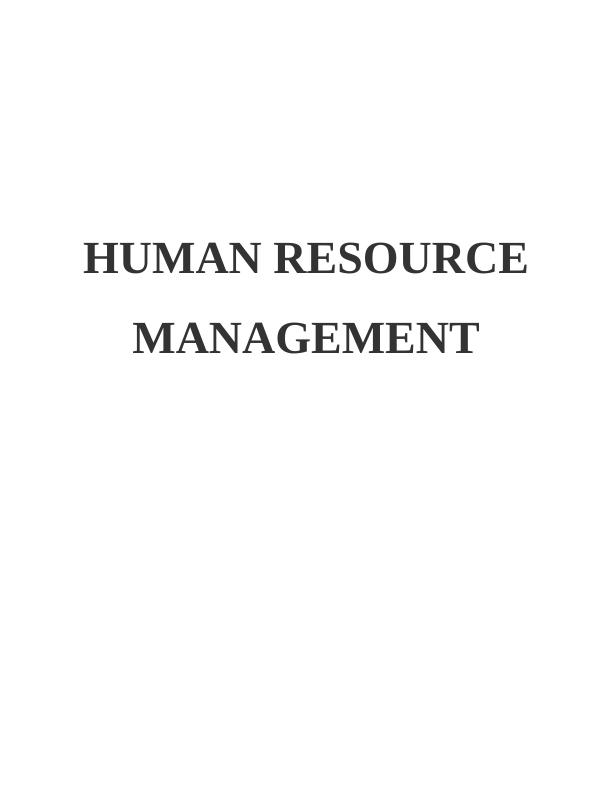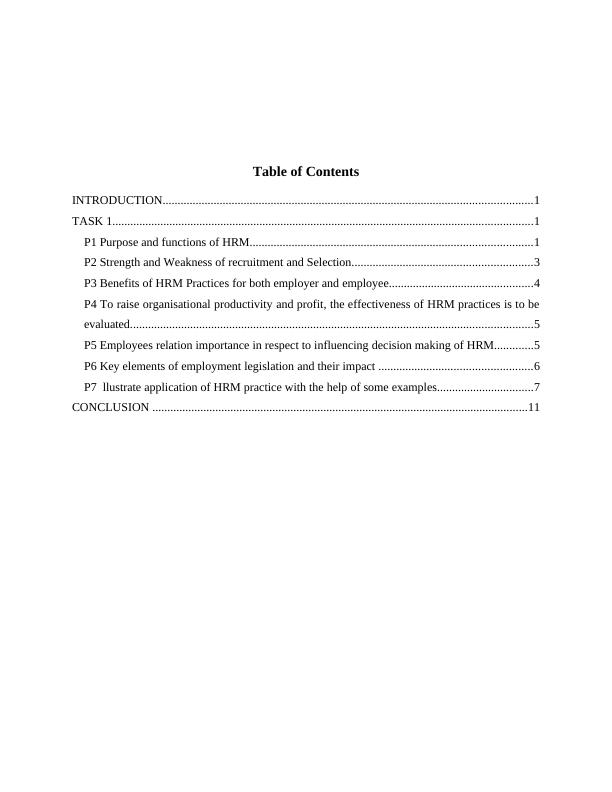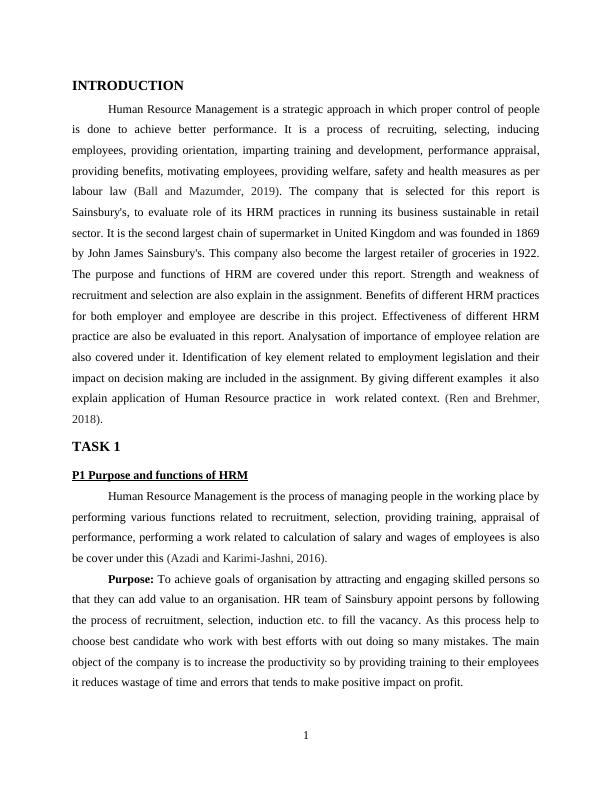Human Resource Management: Purpose, Functions, and Benefits
Added on 2023-01-06
14 Pages3880 Words88 Views
HUMAN RESOURCE
MANAGEMENT
MANAGEMENT

Table of Contents
INTRODUCTION...........................................................................................................................1
TASK 1............................................................................................................................................1
P1 Purpose and functions of HRM..............................................................................................1
P2 Strength and Weakness of recruitment and Selection............................................................3
P3 Benefits of HRM Practices for both employer and employee................................................4
P4 To raise organisational productivity and profit, the effectiveness of HRM practices is to be
evaluated......................................................................................................................................5
P5 Employees relation importance in respect to influencing decision making of HRM.............5
P6 Key elements of employment legislation and their impact ...................................................6
P7 llustrate application of HRM practice with the help of some examples................................7
CONCLUSION .............................................................................................................................11
INTRODUCTION...........................................................................................................................1
TASK 1............................................................................................................................................1
P1 Purpose and functions of HRM..............................................................................................1
P2 Strength and Weakness of recruitment and Selection............................................................3
P3 Benefits of HRM Practices for both employer and employee................................................4
P4 To raise organisational productivity and profit, the effectiveness of HRM practices is to be
evaluated......................................................................................................................................5
P5 Employees relation importance in respect to influencing decision making of HRM.............5
P6 Key elements of employment legislation and their impact ...................................................6
P7 llustrate application of HRM practice with the help of some examples................................7
CONCLUSION .............................................................................................................................11

INTRODUCTION
Human Resource Management is a strategic approach in which proper control of people
is done to achieve better performance. It is a process of recruiting, selecting, inducing
employees, providing orientation, imparting training and development, performance appraisal,
providing benefits, motivating employees, providing welfare, safety and health measures as per
labour law (Ball and Mazumder, 2019). The company that is selected for this report is
Sainsbury's, to evaluate role of its HRM practices in running its business sustainable in retail
sector. It is the second largest chain of supermarket in United Kingdom and was founded in 1869
by John James Sainsbury's. This company also become the largest retailer of groceries in 1922.
The purpose and functions of HRM are covered under this report. Strength and weakness of
recruitment and selection are also explain in the assignment. Benefits of different HRM practices
for both employer and employee are describe in this project. Effectiveness of different HRM
practice are also be evaluated in this report. Analysation of importance of employee relation are
also covered under it. Identification of key element related to employment legislation and their
impact on decision making are included in the assignment. By giving different examples it also
explain application of Human Resource practice in work related context. (Ren and Brehmer,
2018).
TASK 1
P1 Purpose and functions of HRM
Human Resource Management is the process of managing people in the working place by
performing various functions related to recruitment, selection, providing training, appraisal of
performance, performing a work related to calculation of salary and wages of employees is also
be cover under this (Azadi and Karimi-Jashni, 2016).
Purpose: To achieve goals of organisation by attracting and engaging skilled persons so
that they can add value to an organisation. HR team of Sainsbury appoint persons by following
the process of recruitment, selection, induction etc. to fill the vacancy. As this process help to
choose best candidate who work with best efforts with out doing so many mistakes. The main
object of the company is to increase the productivity so by providing training to their employees
it reduces wastage of time and errors that tends to make positive impact on profit.
1
Human Resource Management is a strategic approach in which proper control of people
is done to achieve better performance. It is a process of recruiting, selecting, inducing
employees, providing orientation, imparting training and development, performance appraisal,
providing benefits, motivating employees, providing welfare, safety and health measures as per
labour law (Ball and Mazumder, 2019). The company that is selected for this report is
Sainsbury's, to evaluate role of its HRM practices in running its business sustainable in retail
sector. It is the second largest chain of supermarket in United Kingdom and was founded in 1869
by John James Sainsbury's. This company also become the largest retailer of groceries in 1922.
The purpose and functions of HRM are covered under this report. Strength and weakness of
recruitment and selection are also explain in the assignment. Benefits of different HRM practices
for both employer and employee are describe in this project. Effectiveness of different HRM
practice are also be evaluated in this report. Analysation of importance of employee relation are
also covered under it. Identification of key element related to employment legislation and their
impact on decision making are included in the assignment. By giving different examples it also
explain application of Human Resource practice in work related context. (Ren and Brehmer,
2018).
TASK 1
P1 Purpose and functions of HRM
Human Resource Management is the process of managing people in the working place by
performing various functions related to recruitment, selection, providing training, appraisal of
performance, performing a work related to calculation of salary and wages of employees is also
be cover under this (Azadi and Karimi-Jashni, 2016).
Purpose: To achieve goals of organisation by attracting and engaging skilled persons so
that they can add value to an organisation. HR team of Sainsbury appoint persons by following
the process of recruitment, selection, induction etc. to fill the vacancy. As this process help to
choose best candidate who work with best efforts with out doing so many mistakes. The main
object of the company is to increase the productivity so by providing training to their employees
it reduces wastage of time and errors that tends to make positive impact on profit.
1

Various other purposes are explained in detail in the below mentioned points (Tang and Gao,
2019).
Compensation: With proper analysis of compensation act Sainsbury makes alteration in
the pay structure of the company. Main concern for every employee is to give minimum wages
and salaries as per industrial and labour law application. Various laws related to minimum wages
act, Payment of wages act must be follow by this company. (Sohler and Woodruff, 2018).
Staffing Needs: HRM is used to understand and satisfy the needs of staff . All the
responsibility related to recruitment of employees are also be performed by HRM. Identification
and determination of job duties and skill levels are also done by them.
Performance appraisal: For the growth of any organisation it is necessary to evaluate
the performance of employees. Sainsbury's after doing proper analysation check the performance
level of their employees and also find out the reasons of deviation. (Bernar and Xu.,2017).
Benefits: Calculation and proper documentation related to pension, provident fund,
ESIC, bonus, gratuity, etc. are to be performed by HRM of Sainsbury's.
Law Compliance: All the work are to be performed by HR managers as per applicable
compliances so that to avoid exploitation of labour and employees in the Sainsbury's.
Functions: Various managerial and operative function are performed by HRM of
Sainsbury's.
Recruitment and Selection: Recruitment is the process in which identification, screening,
short listing, interviewing are done for fulfil job vacancy with in an organisation. Selection is
process of selecting suitable candidate for vacated position. By adopting the process manager of
Sainsbury recruit their workers and short-listing is done on the basis analysation so that correct
person is selected that helps to increase profit margin also.
Training and development: Training is the programme in which directions and guidelines
are given to learn the work. Development relates to improvement in the skills that increase their
efficiency level also. By conducting induction programme and conferences managers of
Sainsbury improve the performance of employees.
Employee engagement: It represent the emotional attachment of worker towards their
place of working, colleague, rank with in the company. It also represent the level of enthusiasm
and dedication regarding job. By providing time to time guidance and cooperation it improves
2
2019).
Compensation: With proper analysis of compensation act Sainsbury makes alteration in
the pay structure of the company. Main concern for every employee is to give minimum wages
and salaries as per industrial and labour law application. Various laws related to minimum wages
act, Payment of wages act must be follow by this company. (Sohler and Woodruff, 2018).
Staffing Needs: HRM is used to understand and satisfy the needs of staff . All the
responsibility related to recruitment of employees are also be performed by HRM. Identification
and determination of job duties and skill levels are also done by them.
Performance appraisal: For the growth of any organisation it is necessary to evaluate
the performance of employees. Sainsbury's after doing proper analysation check the performance
level of their employees and also find out the reasons of deviation. (Bernar and Xu.,2017).
Benefits: Calculation and proper documentation related to pension, provident fund,
ESIC, bonus, gratuity, etc. are to be performed by HRM of Sainsbury's.
Law Compliance: All the work are to be performed by HR managers as per applicable
compliances so that to avoid exploitation of labour and employees in the Sainsbury's.
Functions: Various managerial and operative function are performed by HRM of
Sainsbury's.
Recruitment and Selection: Recruitment is the process in which identification, screening,
short listing, interviewing are done for fulfil job vacancy with in an organisation. Selection is
process of selecting suitable candidate for vacated position. By adopting the process manager of
Sainsbury recruit their workers and short-listing is done on the basis analysation so that correct
person is selected that helps to increase profit margin also.
Training and development: Training is the programme in which directions and guidelines
are given to learn the work. Development relates to improvement in the skills that increase their
efficiency level also. By conducting induction programme and conferences managers of
Sainsbury improve the performance of employees.
Employee engagement: It represent the emotional attachment of worker towards their
place of working, colleague, rank with in the company. It also represent the level of enthusiasm
and dedication regarding job. By providing time to time guidance and cooperation it improves
2

End of preview
Want to access all the pages? Upload your documents or become a member.
Related Documents
Benefits of HRM Practices for Employer and Employeelg...
|16
|4877
|21
Benefits and Effectiveness of HRM Practices in Organizationslg...
|15
|4675
|83
P1 Purpose and functions of HRM (doc)lg...
|19
|5269
|208
Human Resource Management - Sainsbury Assignmentlg...
|19
|4585
|35
Human Resource Management Assignment: HRM Tescolg...
|12
|3830
|88
Human Resource Management Unit 3- HRM Practices in an Organisationlg...
|15
|3942
|459
